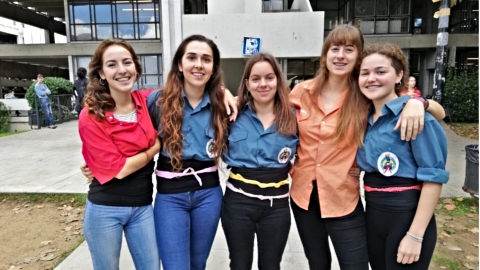“Now most colles will have a Violet Stand in their parties or own protocols”

Marta Alcaraz, anthropology student, and Anna Viñes, biology student, are members of the Gender Committee of the Ganàpies society. The colla castellera approved their Action Guide against Sexism and Gender Violence with the help of Observatori per a la Igualtat and Dinamització Comunitària.
22/10/2018
On the 2017-2018 academic year, the Observatori per a la Igualtat department along with the collaboration of Dinamització Comunitària provided UAB associations with an action guide to tackle sexist situations and gender violence within the association. Every society had to adapt and approve their own guide after making it suitable for their needs.
Many societies participated in the first edition of this guide for UAB associations and the first to present their guide was the Ganàpies society.
We talked to Marta Alcaraz, anthropology student, and Anna Viñes, biology student, two members of the Gender Committee from Ganàpies to know more about the Colla Castellera’s Guide Against Sexism and Gender Violence.
- What was the process that led your society to start working on the creation of the Colla Castellera’s Guide Against Sexism and Gender Violence?
Marta: It was something very internal that we never got to apply because it was still in progress.
A: Later on we contacted you to make an autodiagnosis, which was very useful because that made us decide we should create a more rigorous action guide. We were aware that there were sexist attitudes within the colla but when we shared it with other girls from the society and saw that they went through similar experiences we were even more sure about the need to create this guide so that everyone in Ganàpies would feel comfortable.
- How did you live the autodiagnosis process?
A: As far as we know, the part of the society that criticized the guide more were the veterans or ganapiots (those who used to be ganàpies but now only come to diadas sometimes or random rehearsals).
- Do you appreciate the help you received from Observatori per a la Igualtat and Dinamització Comunitària?
M: While creating the guide, we had you very present in our minds when we had any doubts.
A: We also were provided with the Protocol de la UAB against sexual harassment as reference. That helped us a lot because creating a guide from scratch is very complicated. Having a model was very useful to know exactly what we needed to include in our guide.
- How did the Ganàpies members take the guide after October 4th?
M: The colla reacted very well and many people attended the training.
A: Attendance was very positive and even more considering the fact that many people had lectures in the evening. For this reason we decided to organize more trainings for those who couldn’t come.
M: We wanted to prepare a more dynamic training. The first part consisted in an explanation of the guide, what it is and how it works. In the second part we split into two non-mixed groups to talk a bit about how we felt in the colla. Some girls ran out of time to explain everything and even agreed to meet some other day to continue chatting. The boys’ group focused on analyzing their privileges and power roles.
- Have you started applying the guide ever since its approval?
M: The guide’s theory is really good but you don’t know what your society really needs until you don’t put it into practice. We realized there are things that we could improve and how we could speed some processes up. They are details related with particular cases that you don’t get to realize until you don’t put them into practice.
- In your guide, you differentiate three sections within gender perspective: cultural, procedural and political. Which one do you believe is more urgent in the short term?
- How is gender perspective being worked in universities’ casteller world at the moment?
M: Now most colles will have a Violet Stand in their parties or own protocols.